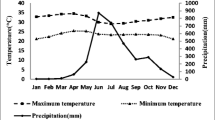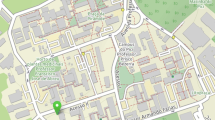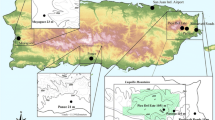Abstract
We examine here the relative influence of natural and anthropogenic forcing on surface air temperature (SAT) variability over the Indian subcontinent (IND) through the analysis of the normalized data of maximum (Tmax), minimum (Tmin), and mean (Tmean/INDSAT) temperatures, total solar irradiance (TSI), El-Nino Southern Oscillations (ENSO), Pacific Decadal Oscillations (PDO), North Atlantic Oscillations (NAO), sea surface temperature (SST), all-India rainfall (AIR), and CO2 using artificial neural networks (ANN). Sensitivity analysis reveals the dependency of each of the natural (e.g. TSI, ocean-atmospheric circulations [OAC, e.g. ENSO, PDO, NAO], SST, AIR) and anthropogenic (CO2) parameters on SAT as follows: (i) SAT is highly sensitive to continuous emission of anthropogenic CO2, (ii) intensive influence of TSI at 11- and 22-year cycles, and (iii) intermittent influence of OAC and SST at low intensive solar radiance. These dependent parameters are used to develop a model to predict future temperatures using multi-perceptron nonlinear feed-forward and back-propagation schemes with a NARX network encoded Bayesian regularization (BR) training algorithm. We used TSI, CO2, OAC, SST, and AIR data as input and Tmean/INDSAT as target (supervised learning). In order to ensure the stable and best possible result, we trained the network successively with different numbers (1–10) of neurons and delay parameters. Optimum mean square error (MSE) and R values (minimum MSE and maximum R value) with eight neurons were found appropriate for the present analysis. We therefore, chose eight neurons to develop a model for training and testing the data and obtained MSE = 0.00039976 and R = 0.98933. This model was validated from 2001 to 2007 and predicted the temperatures from 2001 to 2019 with error ≤ 20%.







Similar content being viewed by others
Change history
20 April 2022
A Correction to this paper has been published: https://doi.org/10.1007/s00024-022-03023-x
References
Abram, N. J., McGregor, H. V., Tierney, J. E., Evans, M. N., McKay, N. P., & Kaufman, D. S. (2016). Early onset of industrial-era warming across the oceans and continents. Nature, 536(7617), 411–418.
Allan, R. J., & Ansell, T. (2006). A new globally complete monthly historical gridded mean sea level pressure dataset (HadSLP2): 1850–2004. Journal of Climate, 19, 5816–5842
Ardalani-Farsa, M., & Zolfaghari, S. (2010). Chaotic time series prediction with residual analysis method using hybrid Elman–NARX neural networks. Neurocomputing, 73(13–15), 2540–2553
Assi, A., Al-Shamisi, M., & Jama, M. (2010). Prediction of monthly average daily global solar radiation in Al Ain City–UAE using artificial neural networks. In: Proceedings of the 25th European Photovoltaic Solar Energy Conference (pp. 508–512).
Banholzer, S., & Donner, S. (2014). The influence of different El Niño types on global average temperature. Geophysical Research Letters, 41(6), 2093–2099
Basha, G., Kishore, P., Ratnam, M. V., Jayaraman, A., Kouchak, A. A., Ouarda, T. B., & Velicogna, I. (2017). Historical and projected surface temperature over India during the 20th and 21st century. Scientific Reports, 7(1), 1–10
Bian, Y. J. (2002). Application of genetic BP network to discriminating earthquakes and explosions. Acta Seismologica Sinica, 15(5), 540–549
Broni-Bedaiko, C., Katsriku, F. A., Unemi, T., Atsumi, M., Abdulai, J. D., Shinomiya, N., et al. (2019). El Niño-Southern Oscillation forecasting using complex networks analysis of LSTM neural networks. Artificial Life and Robotics, 24(4), 445–451.
Chen, W., Feng, J., & Wu, R. (2013). Roles of ENSO and PDO in the link of the East Asian winter monsoon to the following summer monsoon. Journal of Climate, 26(2), 622–635
Chowdary, J. S., John, N., & Gnanaseelan, C. (2014). Interannual variability of surface air-temperature over India: Impact of ENSO and Indian Ocean Sea surface temperature. International Journal of Climatology, 34(2), 416–429
Chylek, P., Tans, P., Christy, J., & Dubey, M. K. (2018). The carbon cycle response to two El Nino types: An observational study. Environmental Research Letters, 13(2), 024001
Coddington, O., Lean, J. L., Pilewskie, P., Snow, M., & Lindholm, D. (2016). A solar irradiance climate data record. Bulletin of the American Meteorological Society, 97(7), 1265–1282
Diaconescu, E. (2008). The use of NARX neural networks to predict chaotic time series. Wseas Transactions on computer research, 3(3), 182–191
Dai, H., & MacBeth, C. (1995). Automatic picking of seismic arrivals in local earthquake data using an artificial neural network. Geophysical Journal International, 120(3), 758–774
Dugam, S. S., Kakade, S. B., & Verma, R. K. (1997). Interannual and long-term variability in the North Atlantic Oscillation and Indian summer monsoon rainfall. Theoretical and Applied Climatology, 58(1–2), 21–29
Graven, H. D., Keeling, R. F., Piper, S. C., Patra, P. K., Stephens, B. B., Wofsy, S. C., & Daube, B. C. (2013). Enhanced seasonal exchange of CO2 by northern ecosystems since 1960. Science, 341(6150), 1085–1089
El-Shafie, A. H., El-Shafie, A., El Mazoghi, H. G., Shehata, A., & Taha, M. R. (2011). Artificial neural network technique for rainfall forecasting applied to Alexandria. Egypt. International Journal of Physical Sciences, 6(6), 1306–1316
Emamgholizadeh, S., Moslemi, K., & Karami, G. (2014). Prediction the groundwater level of Bastam Plain (Iran) by artificial neural network (ANN) and adaptive neuro-fuzzy inference system (ANFIS). Water resources management, 28(15), 5433–5446
Etheridge, D. M., Steele, L. P., Langenfelds, R. L., Francey, R. J., Barnola, J. M., & Morgan, V. I. (1996). Natural and anthropogenic changes in atmospheric CO2 over the last 1000 years from air in Antarctic ice and firn. Journal of Geophysical Research: Atmospheres, 101(D2), 4115–4128
Forkel, M., Carvalhais, N., Rödenbeck, C., Keeling, R., Heimann, M., Thonicke, K., & Reichstein, M. (2016). Enhanced seasonal CO2 exchange caused by amplified plant productivity in northern ecosystems. Science, 351(6274), 696–699
Friis-Christensen, E., & Svensmark, H. (1997). What do we really know about the Sun-climate connection? Advances in Space Research, 20(4–5), 913–921
Govindaraju, R. S. (2000). Artificial neural networks in hydrology. II: hydrologic applications. Journal of Hydrologic Engineering, 5(2), 124–137.
Hagan, M. T., & Menhaj, M. B. (1994). Training feedforward networks with the Marquardt algorithm. IEEE Transactions on Neural Networks, 5(6), 989–993
Hingane, L. S., Rupa Kumar, K., & Ramana Murty, B. V. (1985). Long-term trends of surface air temperature in India. Journal of Climatology, 5(5), 521–528
Huang, F., Huang, J., Jiang, S.-H., & Zhou, C. (2017). Prediction of groundwater levels using evidence of chaos and support vector machine. Journal of Hydroinformatics, 19(4), 586–606
Jallal, M. A., Chabaa, S., El Yassini, A., Zeroual, A., & Ibnyaich, S. (2019). Air temperature forecasting using artificial neural networks with delayed exogenous input. In: 2019 International Conference on Wireless Technologies, Embedded and Intelligent Systems (WITS) (pp. 1–6). IEEE.
Jones, P. D., Jónsson, T., & Wheeler, D. (1997). Extension to the North Atlantic Oscillation using early instrumental pressure observations from Gibraltar and South-West Iceland. International Journal of Climatology, 17, 1433–1450
Karl, T. R., Knight, R. W., & Plummer, N. (1995). Trends in high-frequency climate variability in the twentieth century. Nature, 377(6546), 217
Kayri, M. (2016). Predictive abilities of Bayesian regularization and Levenberg–Marquardt algorithms in artificial neural networks: a comparative empirical study on social data. Mathematical and Computational Applications, 21(2), 20
Kennedy, J. J., Rayner, N. A., Smith, R. O., Parker, D. E., & Saunby, M. (2011). Reassessing biases and other uncertainties in sea surface temperature observations measured in situ since 1850: 1. Measurement and sampling uncertainties. Journal of Geophysical Research: Atmospheres, 116(D14).
Kothawale, D. R., & Rupa Kumar, K. (2005). On the recent changes in surface temperature trends over India. Geophysical Research Letters, 32, L18714. https://doi.org/10.1029/2005GL023.
Kothawale, D. R., Munot, A. A., & Kumar, K. K. (2010). Surface air temperature variability over India during 1901–2007, and its association with ENSO. Climate Research, 42(2), 89–104
Kumari, K. A., Boiroju, N. K., Ganesh, T., & Reddy, P. R. (2012). Forecasting surface air temperature using neural networks. International Journal of Mathematics and Computer Applications Research, 3, 65–78
Knutti, R., Stocker, T. F., Joos, F., & Plattner, G. K. (2003). Probabilistic climate change projections using neural networks. Climate Dynamics, 21(3–4), 257–272
Lean, J., & Rind, D. (1999). Evaluating sun–climate relationships since the Little Ice Age. Journal of Atmospheric and Solar-Terrestrial Physics, 61(1–2), 25–36
Love, B. C. (2002). Comparing supervised and unsupervised category learning. Psychonomic Bulletin & Review, 9(4), 829–835
Lin, Y. C., Zhang, J., & Zhong, J. (2008). Application of neural networks to predict the elevated temperature flow behavior of a low alloy steel. Computational Materials Science, 43, 752–758
Lundstedt, H., & Wintoft, P. (1994). Prediction of geomagnetic storms from solar wind data with the use of a neural network. In: Annales Geophysicae (Vol. 12, No. 1, pp. 19–24). Copernicus GmbH
Kothwale, D. R., & Rupakumar, K. (2005). On the recent changes in surface temperature trends over India. Geophysical Research Letters, 32, L18714
MacKay, D. J. (1992). A practical Bayesian framework for backpropagation networks. Neural Computation, 4(3), 448–472
Maiti, S., Erram, V. C., Gupta, G., Tiwari, R. K., Kulkarni, U. D., & Sangpal, R. R. (2013). Assessment of groundwater quality: a fusion of geochemical and geophysical information via Bayesian neural networks. Environmental Monitoring and Assessment, 185(4), 3445–3465
Maiti, S., Krishna Tiwari, R., & Kümpel, H. J. (2007). Neural network modelling and classification of lithofacies using well log data: a case study from KTB borehole site. Geophysical Journal International, 169(2), 733–746
Maiti, S., & Tiwari, R. K. (2014). A comparative study of artificial neural networks, Bayesian neural networks and adaptive neuro-fuzzy inference system in groundwater level prediction. Environmental Earth Sciences, 71(7), 3147–3160
Mantua, N. J., & Hare, S. R. (2002). The Pacific decadal oscillation. Journal of oceanography, 58(1), 35–44.
Mantua, N. J., Hare, S. R., Zhang, Y., Wallace, J. M., & Francis, R. C. (1997). A Pacific interdecadal climate oscillation with impacts on salmon production. Bulletin of the American Meteorological Society, 78(6), 1069–1080
Marcjasz, G., Uniejewski, B., & Weron, R. (2019). On the importance of the long-term seasonal component in day-ahead electricity price forecasting with NARX neural networks. International Journal of Forecasting, 35(4), 1520–1532
Mitra, A. K., Bohra, A. K., Rajeevan, M. N., & Krishnamurti, T. N. (2009). Daily Indian precipitation analysis formed from a merge of rain-gauge data with the TRMM TMPA satellite-derived rainfall estimates. Journal of the Meteorological Society of Japan Series II, 87A, 265–279
Meehl, G. A., Washington, W. M., Ammann, C. M., Arblaster, J. M., Wigley, T. M. L., & Tebaldi, C. (2004). Combinations of natural and anthropogenic forcings in twentieth-century climate. Journal of Climate, 17(19), 3721–3727
Miao, Q., Pan, B., Wang, H., Hsu, K., & Sorooshian, S. (2019). Improving monsoon precipitation prediction using combined convolutional and long short term memory neural network. Water, 11(5), 977
Minobe, S. (1997). A 50–70year climatic oscillation over the North Pacific and North America. Geophysical Research Letters, 24(6), 683–686
Mooley, D. A., & Parthasarathy, B. (1983). Indian summer monsoon and El Nino. Pure and Applied Geophysics, 121(2), 339–352.
Nayak, P. C., Rao, Y. S., & Sudheer, K. P. (2006). Groundwater level forecasting in a shallow aquifer using artificial neural network approach. Water Resources Management, 20(1), 77–90
Neyamadpour, A., Taib, S., & Abdullah, W. W. (2009). Using artificial neural networks to invert 2D DC resistivity imaging data for high resistivity contrast regions: A MATLAB application. Computers & Geosciences, 35(11), 2268–2274
Neukom, R., Gergis, J., Karoly, D. J., Wanner, H., Curran, M., Elbert, J., & Raible, C. C. (2014). Inter-hemispheric temperature variability over the past millennium. Nature Climate Change, 4(5), 362–367
Nevison, C. D., Baker, D. F., & Gurney, K. R. (2012). A methodology for estimating seasonal cycles of atmospheric CO 2 resulting from terrestrial net ecosystem exchange (NEE) fluxes using the Transcom T3L2 pulse-response functions. Geoscientific Model Development Discussions, 5(3), 2789–2809
Ogurtsov, M. G., Nagovitsyn, Y. A., Kocharov, G. E., & Jungner, H. (2002). Long-period cycles of the Sun’s activity recorded indirect solar data and proxies. Solar Physics, 211(1–2), 371–394
Ozoegwu, C. G. (2019). Artificial neural network forecast of monthly mean daily global solar radiation of selected locations based on time series and month number. Journal of Cleaner Production, 216, 1–13
Padmavathi, B., Rekapalli, R., & Tiwari, R. K. (2019). Role of natural and anthropogenic loadings on Indian temperature trends. Pure and Applied Geophysics, 176(11), 5125–5140
Partal, T., Cigizoglu, H. K., & Kahya, E. (2015). Daily precipitation predictions using three different wavelet neural network algorithms by meteorological data. Stochastic Environmental Research and Risk Assessment, 29(5), 1317–1329
Pant, G., Friis-Christensen, B., & Kumar, K. R. (1997). Climates of South Asia. Wiley-Blackwell.
Peristykh, A. N., & Damon, P. E. (2003). Persistence of the Gleissberg 88-year solar cycle over the last ~ 12,000 years: Evidence from cosmogenic isotopes. Journal of Geophysical Research, 108(A1), 1003. https://doi.org/10.1029/2002ja009390
Rajesh, R., & Tiwari, R. K. (2018). Search for trends and periodicities in inter-hemispheric sea surface temperature difference. Pure and Applied Geophysics, 175(6), 2381–2394
Rigozo, N. R., Nordemann, D. J. R., da Silva, H. E., de Souza Echer, M. P., & Echer, E. (2007). Solar and climate signal records in tree ring width from Chile (AD 1587–1994). Planetary and Space Science, 55(1–2), 158–164
Sahai, A. K., Soman, M. K., & Satyan, V. (2000). All India summer monsoon rainfall prediction using an artificial neural network. Climate Dynamics, 16(4), 291–302
Salem, G. S. A., Kazama, S., Shahid, S., & Dey, N. C. (2017). Impact of temperature changes on groundwater levels and irrigation costs in a groundwater-dependent agricultural region in Northwest Bangladesh. Hydrological Research Letters, 11(1), 85–91
Schlesinger, M. E., & Ramankutty, N. (1994). An oscillation in the global climate system of period 65–70 years. Nature, 367(6465), 723–726
Singh, Y. P., & Singh, M. (2006). Does solar variability affect Indian (Tropical) weather and climate? An assessment. In: ilws, p. 444.
Singh, U. K., Tiwari, R. K., & Singh, S. B. (2005). One-dimensional inversion of geo-electrical resistivity sounding data using artificial neural networks—A case study. Computers & Geosciences, 31(1), 99–108
Sreekanth, P. D., Sreedevi, P. D., Ahmed, S., & Geethanjali, N. (2011). Comparison of FFNN and ANFIS models for estimating groundwater level. Environmental Earth Sciences, 6(62), 1301–1310
Srivastava, A. K., Rajeevan, M., & Kshirsagar, S. R. (2009). Development of high resolution daily gridded temperature data set (1969–2005) for the Indian Region. Atmospheric Science Letters. https://doi.org/10.1002/asl.232
Taormina, R., Chau, K. W., & Sethi, R. (2012). Artificial neural network simulation of hourly groundwater levels in a coastal aquifer system of the Venice lagoon. Engineering Applications of Artificial Intelligence, 25(8), 1670–1676
Tiwari, R. K., & Maiti, S. (2011). Bayesian neural network modeling of tree-ring temperature variability record from the Western Himalayas. Nonlinear Processes in Geophysics, 18, 515–528. https://doi.org/10.5194/npg-18-515-2011
Tiwari, R. K., & Rao, K. N. N. (2004). Signature of ENSO signals in the coral growth rate record of Arabian Sea and Indian monsoons. Pure and Applied Geophysics, 161(2), 413–427
Tiwari, R. K., Rajesh, R., & Padmavathi, B. (2015). Evidence for nonlinear coupling of solar and ENSO signals in Indian temperatures during the past century. Pure and Applied Geophysics, 172(2), 531–543
Tiwari, R. K., Rajesh, R., & Padmavathi, B. (2016). Evidence of higher-order solar periodicities in china temperature record. Pure and Applied Geophysics, 173(7), 2511–2520
Wagle, S., Uttamani, S., Dsouza, S., & Devadkar, K. (2020). Predicting surface air temperature using convolutional long short-term memory networks. In: ICCCE 2019 (pp. 183–188). Springer, Singapore.
Webster, P. J., Magana, V. O., Palmer, T. N., Shukla, J., Tomas, R. A., Yanai, M. U., et al. (1998). Monsoons: Processes, predictability, and the prospects for prediction. Journal of Geophysical Research: Oceans, 103(C7), 14451–14510.
Wolter, K., & Timlin, M. S. (1993). Monitoring ENSO in COADS with a seasonally adjusted principal. In: Proc. of the 17th Climate Diagnostics Workshop, Norman, OK, NOAA/NMC/CAC, NSSL, Oklahoma Clim. Survey, CIMMS and the School of Meteor., Univ. of Oklahoma, 52 (Vol. 57).
Xie, H., Tang, H., & Liao, Y. H. (2009). Time series prediction based on NARX neural networks: An advanced approach. In: 2009 International conference on machine learning and cybernetics (Vol. 3, pp. 1275–1279). IEEE.
Yousef, S. M. (2000). The solar Wolf-Gleissberg cycle and its influence on the Earth. In: ICEHM2000, pp. 267–293.
Zhang, R., & Delworth, T. L. (2005). Simulated tropical response to a substantial weakening of the Atlantic thermohaline circulation. Journal of Climate, 18(12), 1853–1860
Zhang, M., Migliaccio, K. W., Her, Y. G., & Schaffer, B. (2019). A simulation model for estimating root zone saturation indices of agricultural crops in a shallow aquifer and canal system. Agricultural Water Management, 220, 36–49
Zhang, Q., Wang, H., Dong, J., Zhong, G., & Sun, X. (2017). Prediction of sea surface temperature using long short-term memory. IEEE Geoscience and Remote Sensing Letters, 14(10), 1745–1749
Acknowledgements
The authors thank the Director, CSIR-NGRI, for his consent to publish this work. Padmavathi is grateful to DST for awarding the DST-WOSA fellowship and to AcSIR for allowing registration for Ph.D. The authors thank the IMD and IITM for making available the data of Indian temperature and rainfall. The authors also acknowledge the help of Dr. Raju Mandal for providing the average maximum, minimum, and mean surface air temperature time series from 2008 to 2019 and rainfall data from 2017 to 2019, and Wolter and Timlin for providing ENSO Index data, Coddington et al. for the TSI data, Mantua et al. for PDO data, Jones et al. for the NAO data, Kennedy et al. for SST data, and Etheridge et al. for the CO2 data from KNMI Climate Explorer.
Author information
Authors and Affiliations
Corresponding author
Additional information
Publisher's Note
Springer Nature remains neutral with regard to jurisdictional claims in published maps and institutional affiliations.
The original online version of this article was revised due to wrong affiliations and an incorrect author name in the section "About this article".
Rights and permissions
About this article
Cite this article
Padmavathi, B., Tiwari, R.K. & Tiwari, V.M. ANN-Based Assessment of the Influence of Natural and Anthropogenic Forcing on Surface Air Temperature Variability Over the Indian Subcontinent. Pure Appl. Geophys. 178, 1911–1926 (2021). https://doi.org/10.1007/s00024-021-02724-z
Received:
Revised:
Accepted:
Published:
Issue Date:
DOI: https://doi.org/10.1007/s00024-021-02724-z




